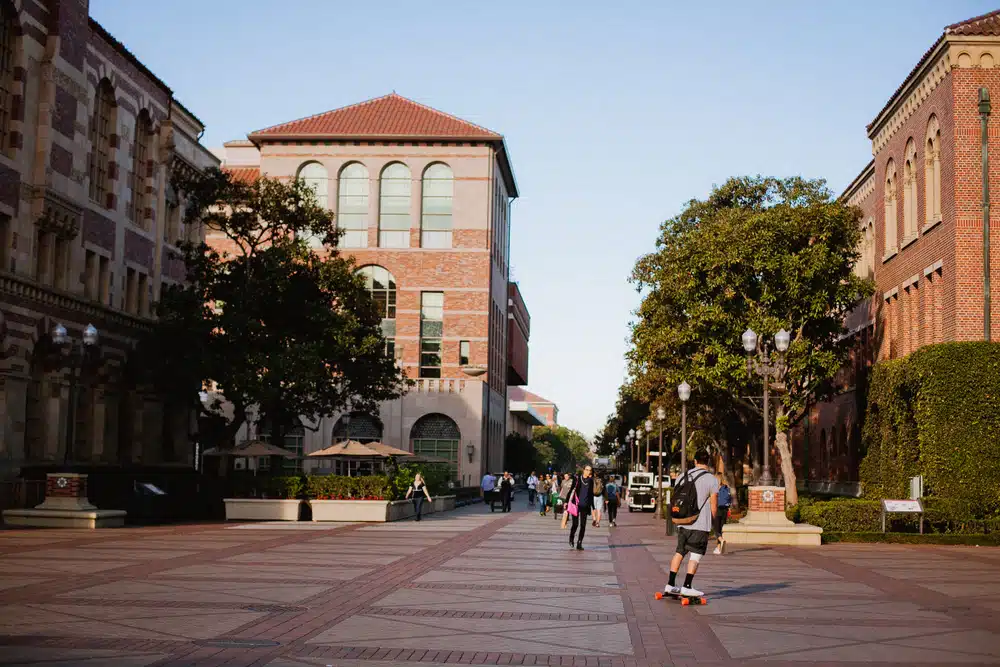Understanding the USC Waitlist for the Class of 2025
The college admissions process can be stressful and confusing, and dealing with the waitlist adds an extra layer of complexity. This article is designed to demystify the University of Southern California (USC) waitlist process for the year 2025. We will explore the USC waitlist and how it works to give you a comprehensive understanding of all associated factors.
The Basics of USC Waitlist
Are you curious about what happens when you’re placed on the USC waitlist? Let’s dive into the details and demystify this process.
What is the USC Waitlist?
When you’re put on the waitlist at the University of Southern California (USC), it means that the admissions committee sees potential in your application. They recognize your achievements and qualifications, but due to space limitations, they cannot offer you a spot immediately.
However, don’t lose heart. Being placed on the waitlist is not a rejection. It’s important to remember that USC uses the waitlist as a way to manage the number of students they admit each year. It’s a situation in which your application will be reconsidered if a spot opens up before the fall semester begins.
So, what does this mean for you? Well, it means that you’re still in the running for admission to USC. You have caught the attention of the admissions committee, and they believe you could be a great fit for the university.
How Does the Waitlist Work?
Once USC receives your university application, they may choose to place you on their waitlist. You will be informed of this decision alongside regular admission results. From that point on, it becomes a waiting game.
As spaces become available in the admitted class, the university will begin to extend offers to students on the waitlist. This process can be unpredictable, as it depends on the number of initially admitted students who decide to enroll at USC.
While there’s no guarantee that you’ll get off the waitlist, remaining on the waitlist means you still have a chance at admission. USC carefully manages its waitlist to ensure that the institution enrolls the desired number of students each year, so your application will continue to be considered until the class is finalized.
It’s important to note that being on the waitlist doesn’t mean you should sit back and wait passively. If you’re truly interested in attending USC, it’s a good idea to let the admissions office know that you’re still very much interested in being admitted. You can send a letter of continued interest or provide any updated information that may strengthen your application.
Remember, being on the waitlist is not a reflection of your abilities or accomplishments. It simply means that USC wants to keep you in consideration for admission, should a spot become available.
So, keep your hopes up and stay positive. The waitlist is not the end of the road, but rather an opportunity to showcase your dedication and enthusiasm for USC.
Factors Influencing the USC Waitlist
Admission Statistics and Trends
The number of students on the USC waitlist fluctuates annually, reflecting the dynamic nature of admissions and the varying pool of qualified applicants.
For Fall 2022, USC placed 5,847 students on their waiting list and eventually admitted 28 students from the USC waitlist pool. In comparison to the USC waitlist for the Class of 2025, out of 8,023 students on the waitlist, USC offered admission to 243 students.
Several factors influence the chances of getting off the USC waitlist. One of these is the university’s admission statistics and trends. Admission rates vary each year depending on the number of applications received and the number of students the university decides to admit.
Looking at the trends over the years can give you an idea of USC’s admission practices. This includes understanding how many students are typically waitlisted, and what proportion of these students end up being admitted. This can give you a fair indication of your chances.
For example, in recent years, USC has seen a steady increase in the number of applications received. This has led to a more competitive admissions process, with a lower acceptance rate. The average acceptance rate at USC for the past decade has been 15.36%, while the current acceptance rate for the 2023-2024 academic year stands at 10 percent.
Additionally, USC takes into consideration various factors when making admission decisions, such as academic achievements, extracurricular involvement, and personal essays. Understanding these factors can help applicants assess their chances of being admitted off the waitlist.
Impact of Early Action on the Waitlist
USC’s early action (EA) process also has a significant impact on the waitlist. Students who apply for EA are filling up many available slots in the freshman class. Consequently, fewer spots may be available for students on the waitlist.
It is important to note that USC’s early action program has gained popularity in recent years. This means that more students are applying through this program, further reducing the number of spots available for waitlisted students.
However, it is not all doom and gloom for waitlisted students. USC understands that the early action process may limit the number of available spots, and they take this into consideration when managing the waitlist. They strive to maintain a diverse and well-rounded freshman class, which means that they may still admit students from the waitlist to achieve this goal.
Furthermore, USC also considers factors such as geographic diversity, legacy status, and underrepresented minority status when making admission decisions for waitlisted students. This means that even if you are on the waitlist, you still have a chance of being admitted based on these additional factors.
Overall, while the impact of early action on the waitlist cannot be ignored, there are still opportunities for waitlisted students to be admitted to USC. It is important to stay positive and continue to showcase your strengths and accomplishments to increase your chances of being accepted off the waitlist.
Navigating the USC Waitlist
Steps to Take After Being Waitlisted
If you find yourself on the USC waitlist, there are steps you can take to increase your chances of admission. One is to express your continued interest in the university. This can be done by sending a letter to the admissions office, demonstrating your commitment to the university and highlighting any additional achievements since your application.
For example, you can mention any recent awards or honors you have received or any significant projects or initiatives you have undertaken. By showcasing your ongoing dedication and accomplishments, you can make a compelling case for why USC should reconsider your application.
Staying academically engaged is crucial too. While waiting for a final decision, it’s important to continue excelling in your courses and taking part in extracurricular activities. These will not only keep you intellectually stimulated but also show the university that you are still serious about your studies and involved in your community.
Consider joining clubs or organizations related to your field of interest, participating in community service projects, or even taking on leadership roles within your school or community. These experiences can demonstrate your passion, drive, and ability to make a positive impact, all qualities that USC values in its students.
Communicating with the Admissions Office
Good communication with the admissions office is essential when you are on the waitlist. Regularly check your email and the status of your application online and respond promptly to any communication from the university. However, be careful not to over-communicate, as this may come across as desperate and annoying.
When responding to any communication from USC, be professional and courteous. Take the time to craft thoughtful and well-written responses that address any questions or concerns they may have. This demonstrates your maturity and professionalism, qualities that can make a positive impression on the admissions committee.
Remember, effectively navigating the waitlist is primarily about demonstrating your continued interest and commitment to the university. Make sure the admissions officer knows that USC is a top choice for you. You can do this by attending any waitlist information sessions or events that USC may offer, and by reaching out to current students or alumni to learn more about their experiences at the university.
Additionally, consider writing a follow-up letter or email to the admissions office, expressing your gratitude for being placed on the waitlist and reiterating your strong desire to attend USC. In this letter, you can also provide any updates on your academic or extracurricular achievements, further showcasing your dedication and growth since submitting your application.
By taking these proactive steps and effectively communicating your continued interest and commitment, you can maximize your chances of being admitted off the USC waitlist. Stay positive, stay engaged, and keep working towards your goal of becoming a part of the Trojan family.
The Pros and Cons of Being on the USC Waitlist
Potential Benefits of Waitlisting
Being placed on the waitlist can be a blessing in disguise. It may give you more time to think about whether USC is the right fit for you. You gain time to visit the campus (if you have not done so), connect with current students, and reach out to faculty members in your intended field of study.
Visiting the campus allows you to immerse yourself in the USC community and get a feel for the campus environment. You can explore the various academic buildings, libraries, and recreational facilities.
Additionally, you can attend information sessions and campus tours to learn more about the university’s programs, resources, and extracurricular activities.
Connecting with current students can provide valuable insights into the USC experience. You can ask them about their academic journey, campus involvement, and favorite aspects of being a student at USC. Their firsthand experiences can help you make an informed decision about whether USC is the right fit for you.
Reaching out to faculty members in your intended field of study can give you the opportunity to learn more about the academic programs and research opportunities available at USC. You can ask them questions about the curriculum, faculty expertise, and potential research projects. This interaction can help you gauge whether USC offers the academic resources and support you need to thrive in your chosen field.
In addition to providing extra time for decision-making, being on the waitlist can also give you additional opportunities to bolster your application. Any significant accomplishments after your initial application can be added to improve your overall applicant profile.
If you have achieved notable milestones or received prestigious awards since submitting your application, you can inform the admissions committee about these accomplishments. This can demonstrate your continued dedication and growth, potentially increasing your chances of being admitted off the waitlist.
Possible Drawbacks and Challenges
However, being placed on the waitlist can also bring about uncertainty. It may be stressful to wait for an unknown outcome while your peers are already securing their college plans. The waitlist may also feel like a prolongation of the college application process, resulting in anxiety and frustration.
During this waiting period, it is important to stay positive and focus on other college options that you may have. It can be helpful to explore alternative schools that align with your academic and personal goals, ensuring that you have backup plans in case you are not admitted off the waitlist.
The waitlist can also make it difficult to plan for the future. You might not know where you will end up until much later in the year, making it hard to plan for housing, orientation, and other important aspects of starting college.
While it can be challenging to navigate this uncertainty, it is important to stay organized and flexible. Keep track of deadlines and important dates for other schools you are considering, and be prepared to make decisions quickly once you receive updates from USC.
Reach out to other schools for information about housing options and orientation programs, so you can be ready to transition smoothly into college life, regardless of the outcome of the waitlist.
Remember, being on the waitlist does not define your worth as a student. It is an opportunity to showcase your continued interest in USC and your commitment to your education. Stay positive, continue to pursue your academic and extracurricular passions, and trust that the admissions committee will make the best decision for both you and the university.
Alternatives to the USC Waitlist
Considering Other College Offers
When you find yourself on USC’s waitlist, it’s vital to cast a wider net and explore other possibilities. If you’ve received acceptance letters from other colleges, it’s wise to take them seriously. Evaluate these alternative institutions based on several factors, including their course offerings, faculty, campus culture, location, and financial aid offerings. By doing this, you’ll be well-prepared with a backup plan in case USC’s decision doesn’t align with your hopes.
Exploring Gap Year Options
Another valuable alternative to consider is taking a gap year. This period could be filled with various enriching experiences, such as travel, internships, work, or other activities that can significantly enhance your personal and professional development. USC, like many other universities, often allows students to defer their admission, granting you an opportunity for growth before embarking on your college journey.
During this gap year, you can build valuable skills and experiences that will make you an even stronger candidate when you decide to reapply to USC or pursue your education elsewhere. This pause in your academic journey can open doors to unique opportunities for self-improvement and exploration.
In conclusion, being placed on the USC waitlist doesn’t mark the end of your educational journey; it’s a detour on the path to your academic goals. Exploring alternatives like considering other college offers and contemplating a gap year empowers you to make informed choices and continue your pursuit of higher education.
By carefully evaluating your options and investing in personal and professional growth, you’ll enhance your chances of gaining admission while gaining a deeper understanding of your educational preferences.
Remember, it’s not just about reaching your destination, but the transformative journey itself that can lead to success. Regardless of the path you choose, your commitment and determination will be your greatest assets in achieving your aspirations.
Additionally, AdmissionsSight, a renowned educational consultancy, can be your invaluable partner in navigating the complex college admissions process. Our team of experienced advisors offers expertise in dealing with waitlisted situations and gap year planning. They provide tailored guidance for assessing your options, refining your application materials, and crafting compelling narratives to showcase your strengths.
Whether you’re considering reapplying to USC or exploring other college choices, AdmissionsSight’s knowledge and expertise will support you on your journey toward higher education, helping you make informed decisions with confidence.










































